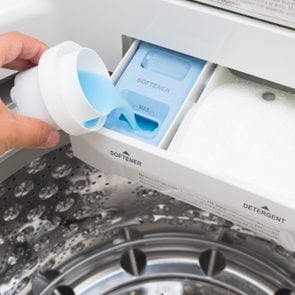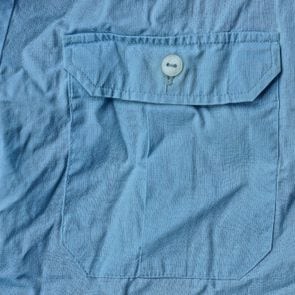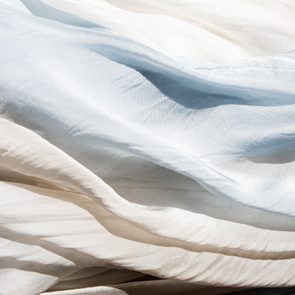How to Wash White Clothes to Keep Them Looking Bright and New
Updated: May 22, 2024

This expert-backed guide will help you achieve and maintain your brightest whites when doing laundry
Even with the most detailed fabric-care label, it can feel like you need a master class on how to wash white clothes. So if your once-bright clothing looks a little worse for wear, you’re not alone. I’m a cleaning expert who’s been talking about, practicing and teaching cleaning on the Clean My Space YouTube channel since 2011, and I too deal with dinginess, stains and yellowing whites.
I’ve turned white socks pink, watched my favorite white knitted sweater become a dingy shade of gray, spotted yellow sweat stains on collars and my shirts’ underarms, and dealt with dingy, oil-stained pillowcases (thanks to my over-the-top nightly skin-care routine). This is real life! But here’s the good news: I have used my knowledge, expertise and deep laundry connections with detergent and appliance manufacturers to refine my approach and equip myself with the right products, tools and techniques to keep my whites from looking dingy or yellow even after many washes.
Ahead, I’ll dive into the specifics of how to wash white clothes—and how to keep your whites looking bright, fresh and crisp. If you’re looking for how to do laundry in an easy and effective way, you’ve come to the right place. Grab your dingiest whites, and let’s get started.
Get Reader’s Digest’s Read Up newsletter for more cleaning, humor, travel, tech and fun facts all week long.
About the expert
|
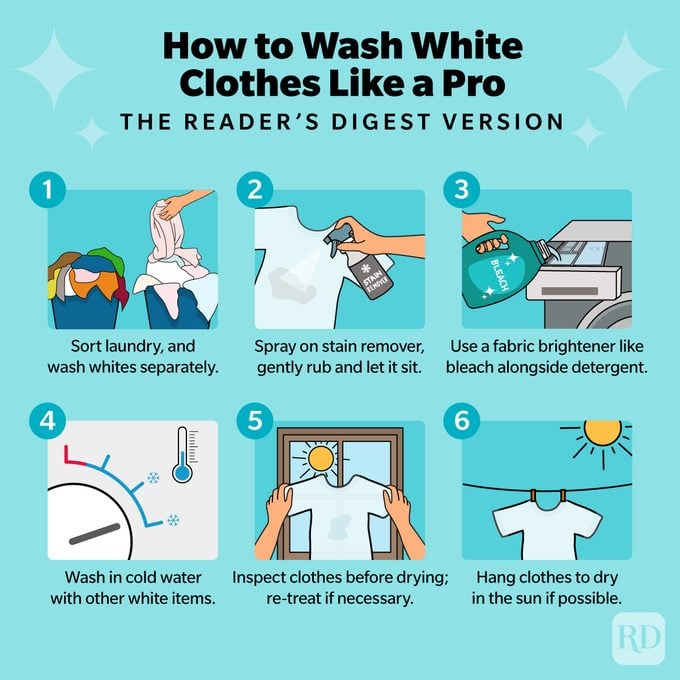
What to do before washing whites
Getting perfectly crisp whites requires some forethought, so start by learning the rules for pre-treating and sorting laundry, along with other considerations to keep in mind before walking your load to the washing machine.
Separate your whites (yes, every time!)
Unless you like your whites to look, well, not white, consider this task a must every time. I rely heavily upon my three-bag laundry sorter, tossing garments directly into the slot meant for either lights, colors or darks. As I place my items into the washing machine, I’ll double-check to ensure a black sock or red T-shirt didn’t accidentally make it into the wrong section of the laundry sorter—one mistake like that is highly consequential.
Another tip for separating laundry: Keep your heavier fabrics away from your lighter ones; towels should be washed separately from clothing. The mix of weights can cause pilling, which ages garments.
Pre-treat your stains
When it comes to stain removal, your first shot is your best shot at getting the stain out, so take it seriously! To remove stains, slip a cloth inside the clothing item to avoid transferring the stain to the other side of the garment. Blot as much of the stain as you can (for food, paint and the like, you may need to scrape up excess first). Then apply the stain-removal product that best targets your type of stain.
If you’re dealing with an oily stain, you’re in luck. I created an entire guide to removing oil stains from clothing. Both oil and grease stains respond well to liquid dish soap or liquid laundry detergent. Apply just enough to cover the stain, agitate with your finger and launder. Laundry expert Mary Marlowe Leverette recommends giving the stain remover at least 15 minutes to begin breaking apart the stain before tossing the clothes into the washer.
For berry, coffee, wine and other stains that have tannins, begin by blotting the stain immediately. Rinse with hot water, then spray an enzyme-based stain remover to cover the stain. Agitate gently with your finger, let it sit for at least 30 minutes and then launder the garment.
Dealing with blood stains? Rinse with cold water and then spray an oxygen bleach or enzyme-based stain remover onto the stain. Gently agitate with your finger or a gentle toothbrush to help the product penetrate the fibers. Allow it to sit for at least 30 minutes before laundering.
I recommend Oxiclean Laundry and Home Stain Remover Spray or Puracy Stain Remover. I’ve had great success using Puracy’s stain-fighter for both tannin-based and blood stains.
Check the fabric-care label
Your whites, like all garments, come in a variety of fabrics and materials—and therefore come with their own sets of care instructions. So before washing, be sure to read the fabric labels.
One instance in which you can overrule the label? Water temperature. Older laundry conventions tell us to wash whites in hot water to brighten dull fabrics. But hot water can cause clothing to shrink and age faster, and because laundry and equipment technology have changed, we can now get terrific results in cold water too. So even if your label says to wash in hot water, cold water will get the job done.
How to wash white clothes
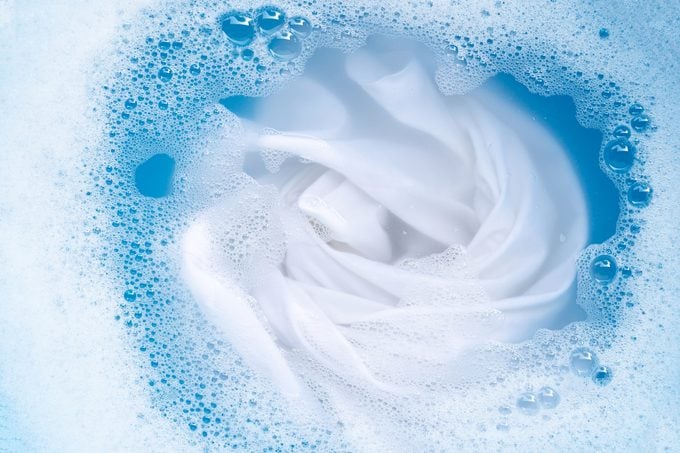
The best way to wash white clothes is to do all the prep work correctly, follow the fabric care label and use premium products to get the best outcome in the first go-round. Keep reading for the flow of washing white clothing that’ll get you those dazzling results.
Supplies you’ll need
- Stain remover
- Premium laundry detergent
- Oxygen bleach or chlorine bleach
- Fabric rinse
- Air-drying rack (or line and clips for drying outdoors)
Step 1: Pre-treat stains
Ideally, you’ll catch stains quickly and treat them as soon as they happen. But if you’re transferring clothing from your hamper to the washing machine and notice a stain you haven’t already treated, now is the time to do so. Refer to the tips above for the best way to remove a variety of stains.
Step 2: Add laundry detergent
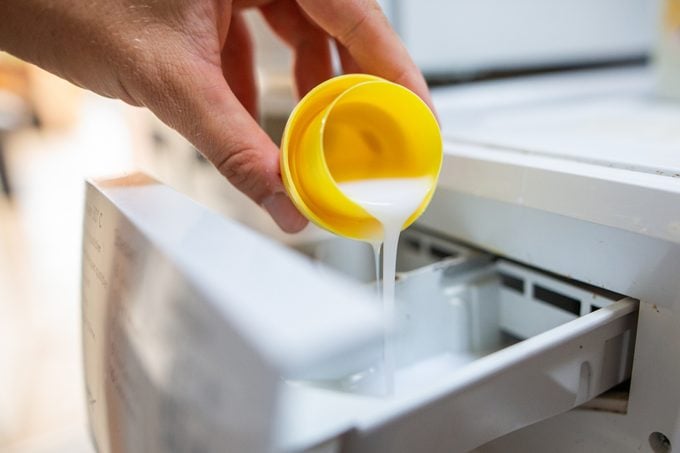
It’s time to add laundry detergent to your machine. Pick one that states it’s able to remove stains and is safe for whites. I have had great results with Tide Hygienic Clean. It’s also formulated to be used in cold water, a bonus.
Step 3: Add a brightening agent
If you’re using bleach, powdered oxygen bleach or a fabric rinse, add it now. Put your preferred laundry booster in the bleach compartment of your machine.
How do you know which add-on laundry products to use? In my experience, most of us fall into one of two camps when washing whites: camp bleach and camp everything-but-bleach. I am in the latter; I simply don’t like bleach in my house. The smell, the possibility of staining and weakening fibers, and the harm it can cause if mixed incorrectly are enough for me to seek alternatives—of which there are many.
I’ve had great results with fabric rinse, which helps wash away detergent residue that can cause dinginess during the rinse phase of the wash cycle. It gets my whites looking their brightest. I use Downy Rinse and Refresh, and I add about 2 tablespoons per load. Fabric rinse will go into the fabric softener compartment of your washing machine.
Should you find yourself in the first camp, ensure you choose premium-quality bleach so that it can protect and brighten your clothing. Remember, bleach does not clean clothes; it simply whitens them.
| ♦ Pro Tip |
| If you’re using laundry detergent packs or powdered oxygen bleach, add them to the drum of your washer before loading your laundry. |
Step 3: Choose your machine settings
Go ahead and add your items to the washer. Once you’ve ensured you’ve got only whites in the load, select the appropriate settings on your washing machine.
While most similarly structured garments have similar washing instructions (for example, all white cotton socks likely have identical care specifications), I tend to select cold water regardless of what the label calls for. See, the label will tell you the hottest possible temperature that the garment can withstand before degradation, but that doesn’t mean it’s the ideal choice. Cold water can help preserve the look and feel of a garment.
There are times, however, when hot water may be the most helpful. “Cotton underwear and socks that are worn close to the body should be washed in hot water to help remove bacteria and sanitize the fabric,” Leverette adds.
When using hot water, ensure each item can withstand that temperature. Some machines come equipped with a “whites” cycle, and it’s important to note that this uses hot water. If that’s what you want, go ahead and select that cycle.
Once you’ve selected the correct settings, start the washing machine.
| ♦ Pro Tip |
| Clean your washing machine regularly. A dirty washing machine cannot get your clothes clean, let alone brighten your whites. If you notice your clothes are coming out looking dingy, run a tub-clean cycle—or the hottest, longest cycle possible—using a washing machine cleaner. Doing this once per month is the best way to ensure consistently clean clothing. |
Step 4: Inspect your just-washed clothes
Before moving your freshly laundered whites into the dryer, check your formerly stained garments. Your goal is to ensure the stains have been lifted entirely. This is an important step, so don’t skip it! Heat from the dryer can set stains.
To check properly, hold the garment that had the stain up to a light source (a window works best) and look through the fabric. If you don’t see a stain outline or any remnants of the stain, you’ve been successful and can place the garment in the dryer. Still see a stain? Repeat the stain-removal steps and try again. Sometimes, you’ll need a few goes before a garment is clear of stains.
Step 5: Dry your clothes
There are no special instructions for drying white garments, so once again, you’ll want to rely on the care label to determine whether you should air-dry or machine-dry items. Remove them from the washing machine and either place them into the dryer or hang them on a drying rack or a laundry line. If you’re on the fence about the drying method, consider hanging your clothes to dry in the sun, which can further brighten your whites.
How to whiten clothes with bleach
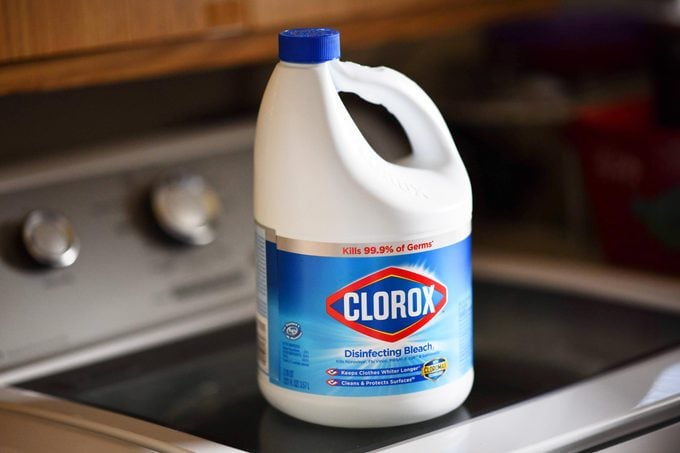
Bleach may be the best-known laundry-whitening product, but it won’t do you any good unless you know how to use it. As bleach brand Clorox points out, using bleach incorrectly will turn garments yellow, which is irreversible.
Common causes of yellowing include using bleach without first diluting it in water or using too much bleach in a given load of laundry. Remember to follow the dosing guide provided on the package for the best results. Yellowing can also occur if you use bleach on certain fabric types. Clorox says that garments made from cotton, polyester, nylon and acrylic are generally safe to use with bleach. In contrast, garments made with wool, silk, mohair, leather and spandex are not—although this is not a comprehensive list. Bleach can also react with certain metals found in water, which can cause yellowing.
That said, if you have dingy or yellowed bedding, clothing or textiles that can tolerate bleach (such as linens, towels, socks, tees and cotton underwear), the product can help you revive their bright white appearance.
Here’s how to wash spandex-free white clothes with bleach:
- Add 1/4 cup of bleach to 1 gallon of cold water.
- Soak the affected items for five minutes.
- Wearing rubber gloves, remove the items and squeeze the liquid out of the clothing.
- Add the items to the washing machine
- Select the hot water cycle.
- Add the correct amount of detergent to the detergent dispenser.
- Add 1/3 cup bleach to the bleach dispenser.
- Start the washing machine.
- Dry according to the instructions on the fabric-care label.
If your garments contain spandex, the above method will almost guarantee yellowing. Instead, try this:
- Add 1 cup of liquid oxygen bleach (such as Clorox 2) to 2 gallons of cold water.
- Soak the affected items for one hour.
- Wearing rubber gloves, remove the items and squeeze the liquid out of the clothing.
- Add the items to the washing machine.
- Select the hot water cycle.
- Add the correct amount of detergent to the detergent dispenser.
- Add 1/3 cup liquid oxygen bleach to the bleach dispenser.
- Start the washing machine.
- Dry according to the instructions on the fabric-care label.
Bleach-free ways to whiten clothes
Since textiles can be delicate and degrade, discolor or turn yellow when exposed to chlorine bleach, many people opt for whitening products that skip the ingredient. Keep these tricks up your sleeve to get your whites their brightest, all without chlorine bleach.
Give garments a borax boost
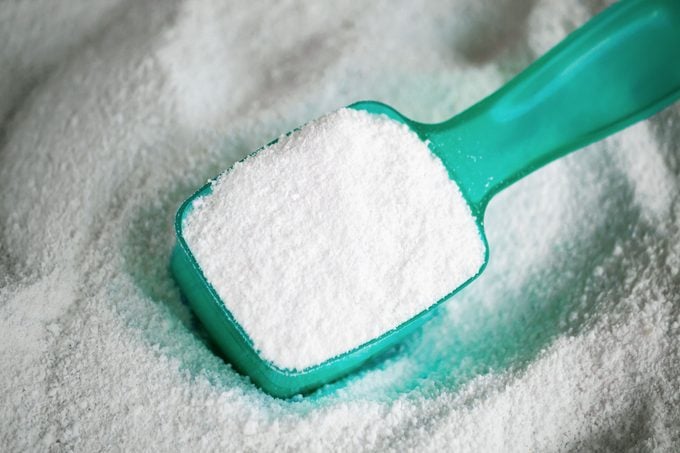
Give your laundry detergent a bump in brightening power by using borax when washing. Here’s how to do that:
- Add 1 tablespoon of borax to 2 cups of boiling water.
- Stir well, until all granules are dissolved.
- Allow the borax solution to cool.
- Add the solution to the bleach compartment of your washer.
- Add detergent, then start your laundry.
Pre-soak in a borax solution
To work out tough stains or yellowing, harness the power of the pre-soak. I do this for my duvet cover because I sleep with layers of skin care products, and they leave my white duvet covered in dingy stains.
There’s a simple recipe to follow, and you can increase or decrease the amount depending on how many items you’ll be adding to the pre-soak or how large those items are. The basic ratio is a half cup of borax for every gallon of water.
You want the water to be hot so the borax will dissolve completely. I like to boil water and pour it into a jar or bucket. I then add the correct amount of borax to the boiling water, let it dissolve and add it to the larger tub of water. This saves me from having to run a super-hot bath when soaking a bunch of clothing at once or an extra-large item, like my duvet.
Ready to try? Gather your dingy whites, then follow these steps:
- Fill a tub or other container with warm water.
- Determine how much borax you need for the amount of water you’re using.
- Boil enough water to dissolve the amount of borax required for your soak.
- Pour the boiling water into a bucket.
- Add the borax to the bucket of hot water and stir until it dissolves.
- Pour the borax solution into the tub of warm water.
- Add your garments.
- Soak for 20 to 60 minutes, depending on the severity of the stains.
- Remove your garments, wringing out as much water as you can.
- Add your garments to the washing machine.
- Launder and dry as usual.
Hang clothes to dry in the sunshine
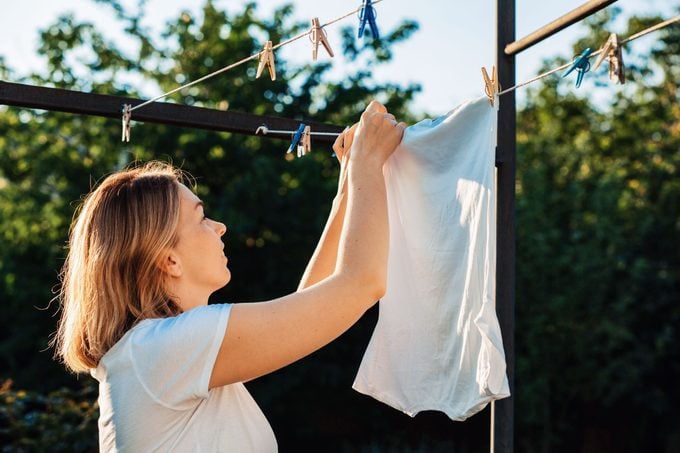
Nothing gets whites brighter than the sun—the UV rays naturally brighten fabrics. So if the weather permits and you have the space, line-dry your white clothing outside so it can reap the benefits of the sun’s natural bleaching.
What’s the best way to get rid of stains on white clothes?
The best way to get rid of a stain on white clothes is to act fast and use a powerful stain remover. A stain on a white garment is akin to a neon sign saying, “Tomato sauce was here.” It’s hard to hide. Thankfully, there are multiple approaches to getting rid of a stain, so let’s have a look at a few that have very high success rates.
Use an enzyme-based stain remover
This is my go-to trick. I find that enzymatic stain remover sprays are the most powerful, even when it comes to grease and blood stains. The one I use is Puracy Stain Remover, and I like it so much because I can spray it on and, once it’s dry, let the garment sit in my laundry hamper until I’m ready to run a load of laundry in that color category. (Hey, it works well for this lazy gal!)
As I do with the other methods, I’ll blot and scrape up as much of the stain as I can, then spray the product onto the stain. I rub it with my finger or a small, gentle brush and then allow it to dry. Within the week, that garment will be laundered, and I am almost always delightfully surprised at how well this works.
Dab on detergent
Liquid laundry detergent and dish soap are great tools for preventing stains from setting in and lifting stains off a garment. Start by scraping up any remaining food or other material covering the stain, then blot the area. Place an old cloth between the garment’s layers to avoid transferring the stain to the other side of the item. Rub just enough liquid laundry detergent or liquid dish soap over the stained area to cover it. You can rub it in with your finger or a soft laundry brush to help the soap penetrate the fibers. Finish by laundering as usual.
Remember, before drying, hold the stained garment up to the light to make sure the stain is gone. If it’s not, don’t place it in the dryer! That could set the stain. Instead, repeat the process until you get rid of the stain.
Spray on stain remover
There are lots of laundry stain removers on the market that work really well, including Oxiclean Laundry and Home Stain Remover Spray, Shout and Tide Rescue Laundry Stain Remover. These are all designed to penetrate stains quickly and help release them from fabrics ahead of laundering.
As with any stain, remove as much of it as you can first by scraping and blotting, then spray the product onto the stained area and let it sit for up to 10 minutes before laundering as usual. Check to ensure the stain is gone before drying, and if it’s not, repeat the process.
How often should you wash whites?
Whites should be washed after each wear because they are not as good at hiding stains as darker fabrics. Plus, body oils and sweat oxidize—think of what happens to a banana or avocado after it’s exposed to air; that’s exactly what happens to our sweat on clothing—and can yellow quickly on whites.
I have yet to take off a white garment that looks clean after one wear. Have you? Whites look great only when they are fresh and clean, the sort of white that pops. If you aren’t getting that, switch up your washing frequency.
What is the best way to care for white clothes?

To keep your whites looking fresh, keep the care tips below in mind.
Store them properly
All clothing, including whites, should be entirely dry before you store it. Put clothes away before they’re fully dry, and they could develop mildew.
If you are storing clothing for the off-season, make sure the container is breathable; your garments may yellow if they can’t “breathe.” A cotton storage bag is ideal. If you want to use a plastic bin, it must be made of cast polypropylene to prevent yellowing gases from being released. Look for the number five within the recycling triangle (usually located on the bottom of the bin) or the letters “PP” to ensure you have the correct type of container.
Remove stains ASAP
The longer a stain sits untreated, the higher the likelihood it’ll be hard to remove. Treat it promptly to keep your whites looking great for a long time.
Separate fabric weights to avoid pilling
Keep white towels away from lighter clothing like T-shirts or knits. The friction caused by these weightier fabrics rubbing against the lighter ones will lead to pilling, which ages clothing quicker and makes it look tired and worn. Instead, wash your towels in a separate load.
Separate whites from the rest of your laundry
This can’t be overstated: If you want the whitest whites, keep them to themselves. If you let them mix with your lights and darks, they’ll pick up dyes from your other garments, which will instantly muddy their look.
Use the right dose of detergent
Too much detergent will leave residue behind and make clothes look dingy. Too little detergent means clothing won’t get cleaned. Find the Goldilocks zone of detergent dosing by reviewing the guide on your detergent package.
FAQs
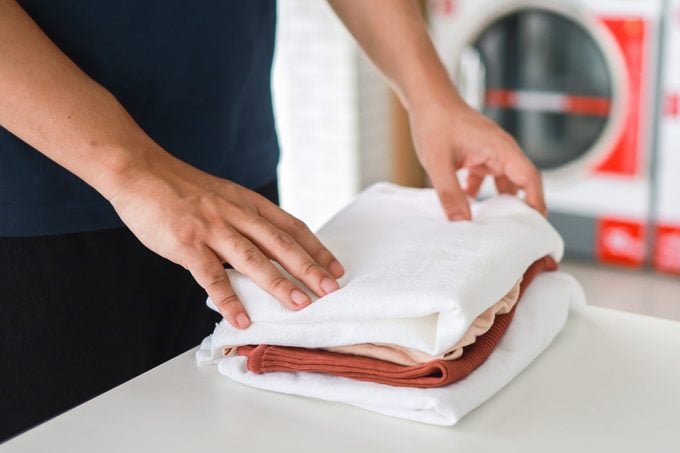
Do you wash white clothes in hot or cold water?
While many folks love washing whites in hot water because of how well it gets rid of stains, hot water ages textiles faster, so it is preferable to wash in cold water when possible. If you’re dealing with heavy staining, you can set your washing-machine temperature to hot—but only if the fabric permits, so be sure to check the care label first. Otherwise, use the techniques mentioned in this article with cold water to preserve the beautiful look of your clothing and keep white garments looking fresh for as long as possible.
What temperature do you wash whites and colors together?
If you’re seeking bright whites, you really shouldn’t be washing whites with colors. (That’s why there isn’t a prescribed temperature for washing them together.)
If you’re at a shared laundry facility and have only one opportunity to do a load, go with cold water. And use a color-absorbing fabric sheet, such as Shout Color Catcher, to help pick up dye in the wash water. There are no guarantees you won’t see dinginess, but this will help to prevent some dye transfer.
Which is better to whiten clothes: vinegar or baking soda?
Neither vinegar nor baking soda is the most effective DIY solution for whitening clothes in the wash. That said, if you want to use vinegar, add it to the rinse cycle to help remove dingy detergent residue and soil trapped in white fabrics.
Baking soda can help brighten clothing, but you would get better results adding a scoop of oxygen bleach powder or liquid oxygen bleach to the bleach compartment. The borax additive mentioned above is also a better option. These are simply more powerful and will yield better results.
How should you wash delicate whites?
To launder delicate white garments, avoid using chlorine bleach and hot water. When washing fancy underwear, silk and other delicates, stick to cold-water washing, hand-washing (if called for) and pre-treating with products safe for the garment’s fabric. (As Leverette mentioned, you can wash your cotton underwear in hot water, though.)
I trust the hand-wash cycle on my washing machine for these delicate items and lean upon my go-to detergent, Tide Hygienic Clean. Otherwise, I’ll hand-wash using cold water and a teaspoon of liquid detergent if I must.
Why trust us
At Reader’s Digest, we’re committed to producing high-quality content by writers with expertise and experience in their field in consultation with relevant, qualified experts. For this piece on how to wash white clothes, Melissa Maker, the cleaning expert behind the popular website and YouTube channel Clean My Space and the founder of a Toronto-based cleaning company, tapped her experience as a cleaning expert, and then fabric-care expert Mary Marlowe Leverette, who has more than 40 years of experience in laundry care and stain removal, gave it a rigorous review to ensure that all information is accurate and offers the best possible advice to readers. We relied on reputable primary sources, including government organizations, as well as our writer’s personal experience. We verified all facts and data and backed them with credible sourcing, and we will revisit them over time to ensure they remain accurate and up to date. Read more about our team, our contributors and our editorial policies.
Sources:


















